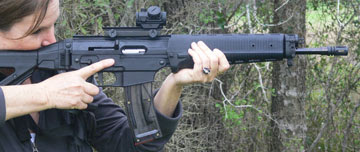As a follow-up to Saturday's post, I thought I would share the list of items I feel my friend should have if she has to "bug out" for home, so to speak. This was our scenario: Some kind of cataclysmic event has occurred....such as an EMP or civil unrest .... and my friend finds herself at work, which is some 30 miles or more from her home. She decides it is best to not wait around for the zombies to run out of food and try to take hers, so she grabs her BOB and starts walking.
Here's what I would want to have with me if I had to trek across country, and of course, the list is subject to your discretion. Some of the items are pricey, but this should be a one-time investment, so my philosophy is start with the best! I've published this list before, but it can't be mentioned enough! And you can buy these items as you can afford them --- just get started!
1. A weapon of your choice
2. Four Mountain House Meals (REI)
3. 1 Titanium cup (
Snow Peak 600) (Amazon)
4. 1 Titanium folding spoon (
Amazon)
5. 1 Katadyn Water Bottle with filter (
Amazon)
6. 1 Esbit Folding Stove (
Amazon)
7. 1 Box Esbit Fuel Tabs (
Amazon)
8. 1 Brunton or Silva Compass (
Amazon)
9. 1 Small First Aid Kit with Bandaids and moleskin
10. 1 Petzl Tikka headlamp for night walking (
Amazon)
11. 1 Whitelight for Shooting (
Fenix, or
Streamlight, for example)
12. 1 Firestarter (Mag Bar with Flint), like a
Doans Firebar, and 1 Bic Lighter
13. A small hank of 550 cord (
Paracord)
14. A rain pancho or 6 x8 cheap blue tarp.
15. 2 pair
Smart Wool hiker socks
16. Bug Spray with Deet
17. Light folding knife
18. Knipex nippers, or a Leatherman tool. (
Knipex are the best, but they are pricey).
19. For winter, a quality wool sweater or coat (like Filson)
 |
| Denzel has the right idea in "The Book of Eli" |
Your weapon of choice is a personal decision, but weight is the obvious issue if you are small statured. My personal recommendation, based on that criteria, is a polymer-framed Glock 19, with a Kydex holster....lots of fire power, and no weight. That's also why I've included titanium items versus stainless steel. The Esbit stove heats water or your meals, and takes up no room. The First Aid Kit is mostly to take care of your feet. If you haven't broken in those hiking boots, now is the time! If your feet quit....you quit.
The Petzl headlamp is a long-burn LED with several settings. It's a must for night walking. But you can't rely on your headlamp if you have to defend yourself. A Streamlight is a short-burn, gun-fighting, defense light. Unfortunately, you will probably need both lights.
And you need two ways to be able to start a fire. Remember my post on "Two is One, and One is None?" Fire-starting is one place you want redundancy! A rain poncho or tarp is to stop hypothermia if you have to bug out in a rain. I like the pancho because you can keep moving while staying dry.
The Smart Wool hikers are easy on the feet, prevent blisters, are cool in summer and warm in winter. I wouldn't start a 30-mile trek without them, if I had a choice. And the Knipex nippers are expensive, but they can get you through any fence, and they have a bolt cutter fulcrum design that allows a woman to cut heavy gauge wire with ease. I would consider a Filson mackinaw cruiser wool jacket or sweater for warmth in the winter. They are sturdy and warm.
While this may seem like an extensive (and heavy) list, I think you will find that most of these items won't add any significant weight, and you'll be able to manage your pack quite easily. With these items, you should have everything you need to make it home safely.
Oh, there's one more thing.....if it's up to me, my BOB is always going to have some element of chocolate. May as well have some comfort food if you're bugging out!
Psalm 23:4 "Even though I walk through the darkest valley, I will fear no evil, for you are with me; your rod and your staff, they comfort me."










































